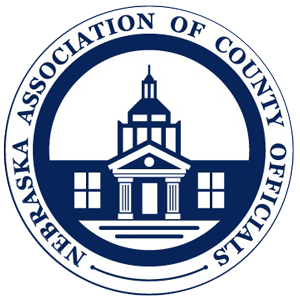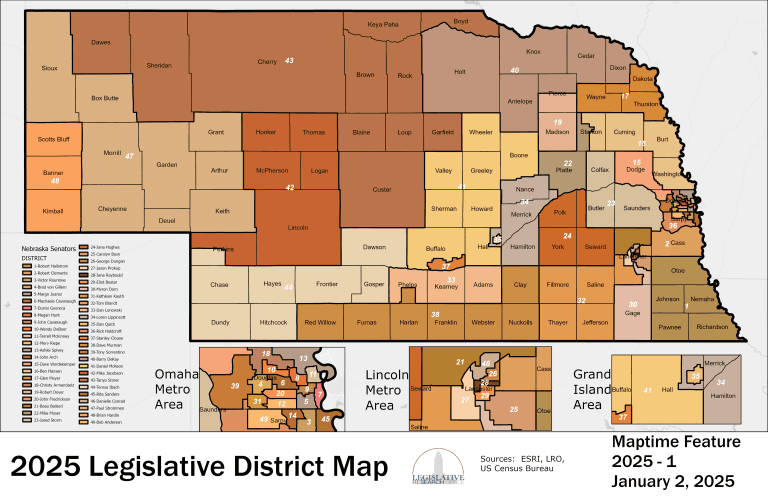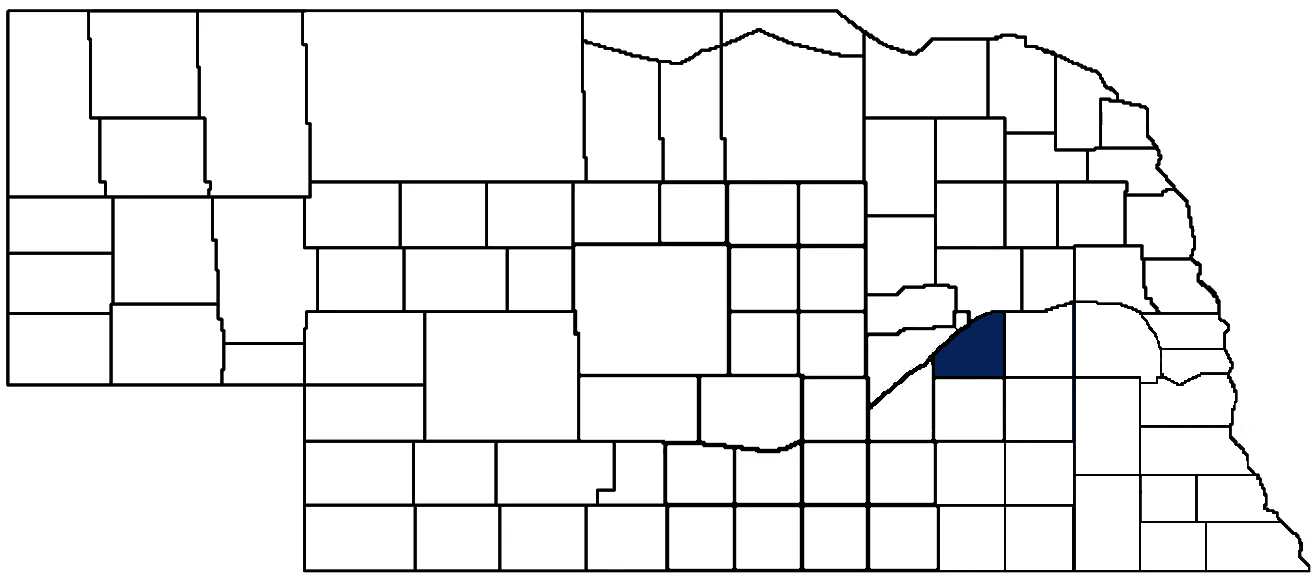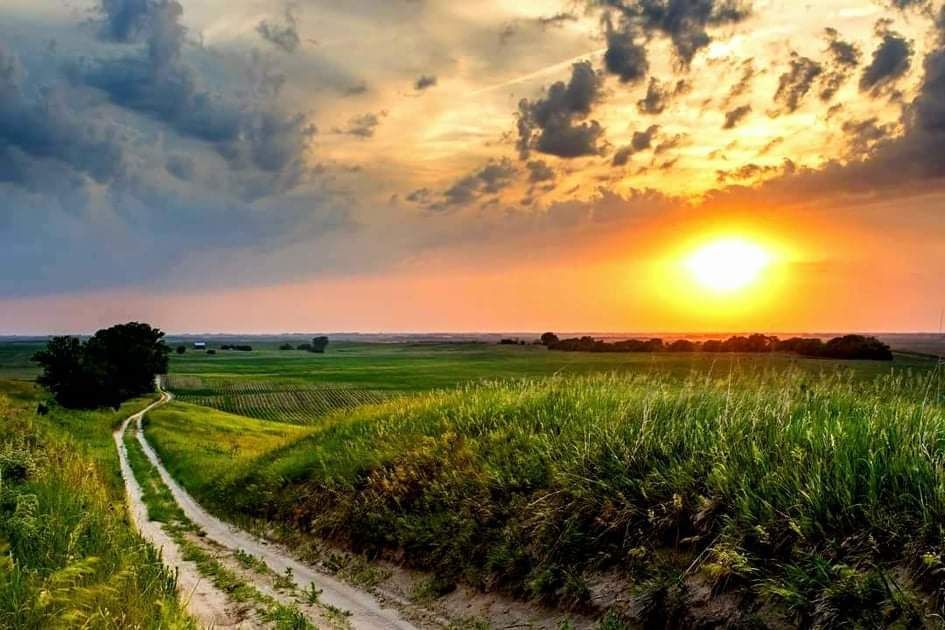- General Info
- Demographics
- Education and Employment
- Valuation and Taxes Levied
- State Senators
- History
- County Programs
- Other Information
Communities and Development
Polk County Seat: Osceola
Cities, Towns, and Villages (pop.): Polk (346), Shelby (710)
Total County Population: 5,214
- Cities (pop. & class): Osceola (875 • 2nd Class), Stromsburg (1,143 • 2nd Class)
- Villages (pop.): Polk (346), Shelby (710)
- Unincorporated Pop. (% of county pop.): 2,140 (41%) 2020
Land Development (% of total land in county):
- Agriculture: 91%
- By method: Irrigated (row crop/grain/forage) (65%); Dryland (row crop/grain/forage) (14%); Pasture (pure grassland) (11%) • Neb. Dept. of Rev. - total equals agriculture's %
- By commodity: Corn 46%, Soybeans 32%, Livestock (grassland) 11%, Alfalfa 1% • USDA - equals agriculture's % plus some wetlands (2%) and minus public grassland/wetlands and reserve
- Residential, Commercial, Industrial, Conservation Reserve & Exempt (combined): 8%
- Timber: 2% 2022
County Offices
Courthouse Address and Hours:
400 Hawkeye Street
Osceola, Nebraska 68651
M-F 8:00 am - 5:00 pm
County Board Chairperson: Jerry Westring
Complete list of county board members
County Board Meetings: 1st, 3rd & 4th Tuesday
View the County's Government Maps
NACO District: Central
General
Population: 5,214
Land area (sq. mi.): 438.67
Population per square mile: 11.9
Race and Age
Race 2020
White: 91.1%
African American: 0.2%
American Indian: 0.3%
Asian: 0.0%
Hispanic: 5.0%
Native Hawaiian and Pacific Islander: 0.0%
Two or More Races: 3.2%
Age 2020
0-17: 22.7%
18-64: 54.2%
65+: 23.1%
Households
Total households: 2,146 2020
With one child: 240 2022
With 2+ children: 330 2022
With seniors (65+): 630 2022
Socioeconomics
Median household income: $71,771 2023
% of Population in Poverty: 7.8% 2023
# of Housing Units: 2,524 2020
Owner-occupied rate: 79.6% 2020
Median home price: $192,330 Q4 2024
2024 building permits for detached single family homes: 14
2024 building permits for non-detached housing units: 0 (townhouse, duplex, or apt. unit)
Technology
Access to broadband (100 Mbps via fiber or cable modem): 59.5% 2021
Sources: National Association of Realtors, Nebraska Department of Revenue, Nebraska Legislature, Nebraska Library Commission, U.S. Bureau of Economic Analysis, U.S. Census Bureau (building permits), U.S. Census Bureau (demographics), U.S. Census Bureau (municipalities)
Employment, Schools, and Child Care
Unemployment rate: 2.4% March 2025
County Employment Website: https://nebraskacounties.org/nebraska-counties/county-employment-opportunities.html
High school graduate or higher: 90.2% 2020
School Districts: Centennial Public Schools, Columbus Public Schools, Cross County Community Schools, High Plains Community Schools, Osceola Public Schools, Shelby-Rising City Public Schools, Twin River Public Schools
Bachelor's degree or higher: 19.2% 2020
Community College Service Area: Central Community College
Countywide child care capacity: 12 providers; 130 children
Find child care: For a list of child care providers in your zip code, visit Nebraska DHHS or the Nebraska Resource and Referral System.
Polk County Economy
Annual Gross Domestic Product (GDP): $442,555,000 2023
Nonfarm Small Business Receipts: $51,753,813 2022
Nonfarm Wage Income: $113,494,000 2022
Farm and Ranch Commodity Sales Receipts: $356,056,000 2022
Farm and Ranch Operations (Non-Sales) Receipts: $7,758,000 2022
- For components of nonfarm small business receipts, nonfarm wage income, and farm & ranch commodity sales and operations receipts, see "Notes" below.
Grain Elevators by Location (bushels capacity):
- Osceola: Frontier (1,182,630)
- Polk: CVA (5,463,000)
- Shelby: CVA (3,777,000)
- (1 bushel = 56 lbs. corn/sorghum, 60 lbs. soybeans/wheat; % max. moisture = 18% beans, 15.5% corn, 14% sorghum/soybeans, 13.5% wheat)
Railroad Miles: 56.50 main, 8.38 side
- Places with Railroad Service: Osceola, Polk, Shelby, Strombsburg
Local Grain Market: Click for today's grain prices in Polk County
Cattle Producers: 125
Crop Producers: 298
- Dryland Cash Rent (avg.): $195/acre
- Irrigated Land Cash Rent (avg.): $287/acre
Dairy Producers: 2
Farmers Market: Osceola Farmers Market (July - August, Wednesdays 5:00 - 7:00 p.m.)
Electricity Providers: City of Stromsburg, Polk County Rural PPD, Village of Polk
Wind Turbines Operating (MW): 1 turbine (2,500 MW total)
Irrigation and Drinking Water
Rural Irrigation Wells: 1,943 2024
Rural Livestock Wells: 93 2024
Rural Commercial/Industrial Wells: 6 2024
Rural Drinking Water Wells: 325 2024
Drinking Water Utility Connections: 1,377 Residential; 179 Commercial; 1 Industrial 2024
Surface Water Diversions (Irrigation): 36 2024
Click for real time:
Streamflow data on Clear Creek (1.75 mile west of the county's eastern border)
Notes
Polk County Economy
- Nonfarm small business receipts are reported by partnerships and sole proprietorships. They do not include receipts reported by cooperative associations.
- Nonfarm wage income is reported based upon the wage earner's residential address; therefore, it also includes wages earned by Polk County residents in other counties or states, but it excludes wages earned in Polk County by residents of other counties or states.
- Nonfarm wage income excludes wages earned by anyone claimed as a dependent.
- Farm and ranch commodity sales receipts and operations receipts are reported based upon the farm or ranch owner's principal county of operations; therefore, those figures also include receipts reported by producers operating principally in Polk County for their production in other counties or states, but the figures exclude receipts reported for production in Polk County by producers operating principally in other counties or states.
Irrigation and Drinking Water
- A rural irrigation well is any well intended for irrigating crops that, either on its own or as part of a set of commingled wells, is capable of pumping more than fifty (50) gallons of water per minute (gpm). Note that some rural commercial/industrial wells are also capable of pumping more than 50 gpm. In Nebraska, the owner of any well--or set of commingled wells--that is capable of pumping more than 50 gpm must register the well(s) with the state government and have a permit for the well(s) from the local natural resource district (NRD).
- Rural livestock wells and rural drinking water (also known as "domestic") wells are not allowed to pump more than 50 gpm unless permitted by the local NRD. Each rural drinking water well usually serves one single family home, though in rare cases a rural drinking water well serves multiple homes.
- Data on rural livestock wells and rural drinking water wells may be incomplete for wells drilled prior to September 9, 1993. State law does not require wells drilled prior to that date to be registered with the state government if the wells are not capable of pumping more than 50 gpm. Neb. Rev. Stat. § 46-735; see Laws 1993, LB 131, § 25.
Sources: National Agricultural Statistics Service (USDA), Nebraska Cooperative Council, Nebraska Coordinating Commission for Postsecondary Education, Nebraska Department of Health and Human Services, Nebraska Department of Revenue, Nebraska Department of Transportation, Nebraska Office of the CIO, Nebraska Power Review Board, Nebraska Public Service Commission, U.S. Bureau of Economic Analysis, U.S. Bureau of Labor Statistics, U.S. Census Bureau, U.S. Energy Information Administration, U.S. Department of the Treasury (IRS), Warehouse and Commodity Management Division (USDA)
2024 Levies and Valuation
County levy rate: $0.2026 per $100 of taxable valuation
County property taxes levied: $4,421,946
Total local government property taxes levied: $22,645,309
Total countywide taxable valuation: $2,182,650,163
Click here for all levy rates in Polk County
County Levy and Taxation Laws
Levy limits
Since 1996, counties and other political subdivisions have been subject to the levy limits listed in Neb. Rev. Stat. § 77-3442 and Neb. Rev. Stat. § 77-3443.
Statutes and regulations
Nebraska Revised Statutes (Chapter 77)
Nebraska Administrative Code (Title 350)
Local tax reductions, exemptions, and credits
Neb. Rev. Stat. § 76-902(5)(a) (Deed "stamp tax" exemption): "The [stamp tax] shall not apply to: ... (5)(a) Deeds between spouses, between ex-spouses for the purpose of conveying any rights to property acquired or held during the marriage, or between parent and child, without actual consideration therefor."
Neb. Rev. Stat. § 77-201(2) (Valuation of agricultural land and horticultural land): "Agricultural land and horticultural land as defined in section 77-1359 shall constitute a separate and distinct class of property for purposes of property taxation, shall be subject to taxation, unless expressly exempt from taxation, and shall be valued at seventy-five percent of its actual value, except that for school district taxes levied to pay the principal and interest on bonds that are approved by a vote of the people on or after January 1, 2022, such land shall be valued at fifty percent of its actual value."
Neb. Rev. Stat. § 77-6703(1) (Tax credit for school district taxes paid): "(1) For taxable years beginning or deemed to begin on or after January 1, 2020, under the Internal Revenue Code of 1986, as amended, there shall be allowed to each eligible taxpayer a refundable credit against the income tax imposed by the Nebraska Revenue Act of 1967 or against the franchise tax imposed by sections 77-3801 to 77-3807. The credit shall be equal to the credit percentage for the taxable year, as set by the department under subsection (2) of this section, multiplied by the amount of school district taxes paid by the eligible taxpayer during such taxable year."
Sources: Nebraska Department of Revenue
State Senator: Jana Hughes (District 24)
Committees
- Education
- Natural Resources
- Building Maintenance
- Education Commission of the States
- Midwestern Higher Education Compact Commission
Map and statistics for Legislative District 24
Map of all districts in the Nebraska Unicameral Legislature
Polk County History
Number of Registered Historic Places: 6
Year Authorized: 1856
Year Organized: 1870
Etymology: James Polk (11th U.S. president)
Members of the Territorial Legislature established a series of county boundaries along the Platte River on Jan. 26, 1856. At the time Polk County was part of a larger Butler County. Fourteen years later, a special election resulted in the creation of the present day Polk County, named after the 11th president of the United States, James Knox Polk.
When the county was organized in 1870, there was no county seat or courthouse. Each county official who had been elected at an August election conducted county business from his residence.
In October 1871, county residents voted to make the settlement of Osceola the county seat. County commissioners approved the construction of a frame courthouse and took possession of the building when it was completed in 1872. Unfortunately, the courthouse was destroyed by fire nine years later and many of the county's documents were lost.
One year after the destructive fire, a new courthouse was opened. The brick building, which cost $10,000, became a source of pride for county residents. With the publicity the courthouse received when it opened in 1882, it was soon being visited by people from outside the county. In fact, an excursion train was run from David City in neighboring Butler County to bring visitors to see the new building.
As the 20th century began, like so many other counties in the state, Polk County found itself outgrowing its courthouse. So in 1922 the present courthouse was constructed. The three-story building was an architectural landmark. Around a steel reinforced frame was built a modern renaissance exterior that featured terra cotta trim. The interior of the building was highlighted with marble stairs and wainscoting.
Polk County was developed as an agricultural area. Despite severe storms, blizzards and an infestation of grasshoppers in the 1870s and 1880s, those who made a living off the land persevered. That same hearty spirit is prevalent today as the county's economy is based primarily on family farming and livestock production.
Highlight an important program in your county in this space! Send an email to:
Local Highlights
License Plate Number: 41
Time Zone: Central
Zoned County: Yes
Number of Veterans: 311 2023
County Hospital: Annie Jeffrey Memorial County Health Center
Number of County-Owned Bridges: 79
Number of County-Owned Dams: 1
Election Data
General Election Turnout: 79% 2024
Total Registered Voters: 3,643 2024
Number of Precincts: 6 2022
Number of Election Day Polling Places: 5 2022
Land Area per Polling Place (avg.): 88.13 sq. miles
Intergovernmental Data
Emergency Mgt. Planning, Exercise and Training (PET) Region: East Central
Natural Resource Districts: Central Platte NRD, Upper Big Blue NRD
State Lands (acres): Flatsedge WMA (79.50)
Sources: Nebraska Department of Transportation, Nebraska Emergency Management Agency, Nebraska Game & Parks Commission, Nebraska Legislature, Nebraska Office of the CIO, Nebraska Secretary of State, U.S. Department of Veterans Affairs, U.S. Election Assistance Commission, U.S. National Archives and Records Administration (eCFR)



